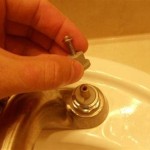Upgrade Bathroom Sink
An outdated or damaged bathroom sink can significantly detract from the overall aesthetic and functionality of a bathroom. Upgrading the sink is a relatively straightforward project that can yield impressive results in terms of both appearance and usability. This article will guide readers through the essential considerations and steps involved in upgrading a bathroom sink.
Choosing the Right Sink
Selecting the right sink is the first and most crucial step in the upgrade process. Several factors influence the choice of sink, including the bathroom's size, existing plumbing, and desired style.
Key considerations include:
- Sink Type: Common types include undermount, drop-in, vessel, pedestal, and wall-mounted sinks. Each type has its own installation requirements and aesthetic implications.
- Material: Popular sink materials include porcelain, ceramic, vitreous china, cast iron, stainless steel, composite materials, and glass. Material choice impacts durability, ease of cleaning, and resistance to staining and chipping.
- Size and Shape: Measure the available counter space and consider the overall bathroom design when choosing the sink's size and shape. Standard sink dimensions vary, so careful measurement is essential.
- Number of Basins: Single or double basin sinks offer different levels of functionality, influencing workflow and user experience within the bathroom.
- Faucet Compatibility: Ensure the chosen sink is compatible with the desired faucet type and configuration. Some sinks have pre-drilled holes for faucets, while others require separate faucet installation.
Preparing for Installation
Adequate preparation simplifies the installation process and minimizes potential complications. Before beginning the actual installation, several preparatory steps are essential.
Key preparatory steps include:
- Turn Off Water Supply: Locate the shut-off valves under the sink and turn off both the hot and cold water supply lines.
- Disconnect Plumbing: Disconnect the water supply lines and the P-trap from the old sink. Have a bucket handy to catch any remaining water in the pipes.
- Remove the Old Sink: Depending on the sink type, this may involve unscrewing mounting brackets, loosening caulk, or cutting adhesive. Carefully remove the old sink and dispose of it properly.
- Clean the Area: Thoroughly clean the countertop or vanity surface where the new sink will be installed. Remove any old caulk or adhesive residue.
- Gather Necessary Tools: Assemble all required tools, including wrenches, pliers, screwdrivers, putty knife, caulk gun, and safety glasses.
Installing the New Sink
The installation process varies depending on the type of sink being installed. However, some general steps apply to most sink installations.
Key installation steps include:
- Apply Caulk or Sealant: If required, apply a bead of plumber's putty or silicone caulk around the drain opening or the sink's perimeter depending on the sink type.
- Position the Sink: Carefully position the new sink in the desired location, ensuring proper alignment and fit.
- Secure the Sink: Depending on the sink type, secure the sink using mounting clips, brackets, or adhesive. Follow the manufacturer's instructions for specific mounting procedures.
- Connect the Plumbing: Connect the water supply lines and the P-trap to the new sink, ensuring tight connections to prevent leaks.
- Apply Finishing Touches: Clean up any excess caulk or sealant. Install the faucet and drain assembly according to the manufacturer's instructions.
- Test for Leaks: Turn the water supply back on and check for leaks around the sink, faucet, and drain connections. Tighten any loose connections as needed.
Choosing the Right Faucet
The faucet is an integral part of the sink upgrade, impacting both functionality and aesthetics. Choosing the right faucet complements the new sink and enhances the overall bathroom experience.
Key faucet selection considerations include:
- Faucet Style: Various faucet styles, such as single-handle, double-handle, and widespread, offer different levels of control and design appeal.
- Finish: Faucet finishes, including chrome, brushed nickel, oil-rubbed bronze, and matte black, contribute to the overall bathroom aesthetic.
- Features: Consider features such as pull-down sprayers, touchless operation, and water-saving aerators to enhance functionality and efficiency.
Maintaining Your New Sink
Proper maintenance ensures the longevity and continued beauty of the new sink. Regular cleaning and careful handling prevent damage and maintain hygiene.
Key maintenance tips include:
- Regular Cleaning: Clean the sink regularly with a mild cleanser and a soft cloth or sponge. Avoid abrasive cleaners and scouring pads, which can scratch the surface.
- Prevent Clogs: Avoid pouring grease or other substances that can clog the drain. Use a strainer to catch hair and debris.
- Address Leaks Promptly: Repair any leaks as soon as they are noticed to prevent water damage and further plumbing issues.

Paint Bathroom Vanity Countertop Sink So Easy A Piece Of Rainbow

Bathroom Vanity Styles To Fit Your Space Forbes Home

How To Choose The Right Bathroom Sink

Updating A Bathroom Vanity

The Double Sink Vanity 6 Bathrooms Get 2x Space Style Sweeten Com

Bathroom Remodeling Fixtures Hardware Bath Barn

2024 Cost To Replace Bathroom Countertop A Guide

Transform Your Bathroom With Sink Paint The Honeycomb Home

10 Diy Bathroom Vanity Ideas The Family Handyman

Dual Or Single Bowl Vanity Is One Two Master Bathroom Sinks Best Degnan Design Build Remodel
Related Posts







